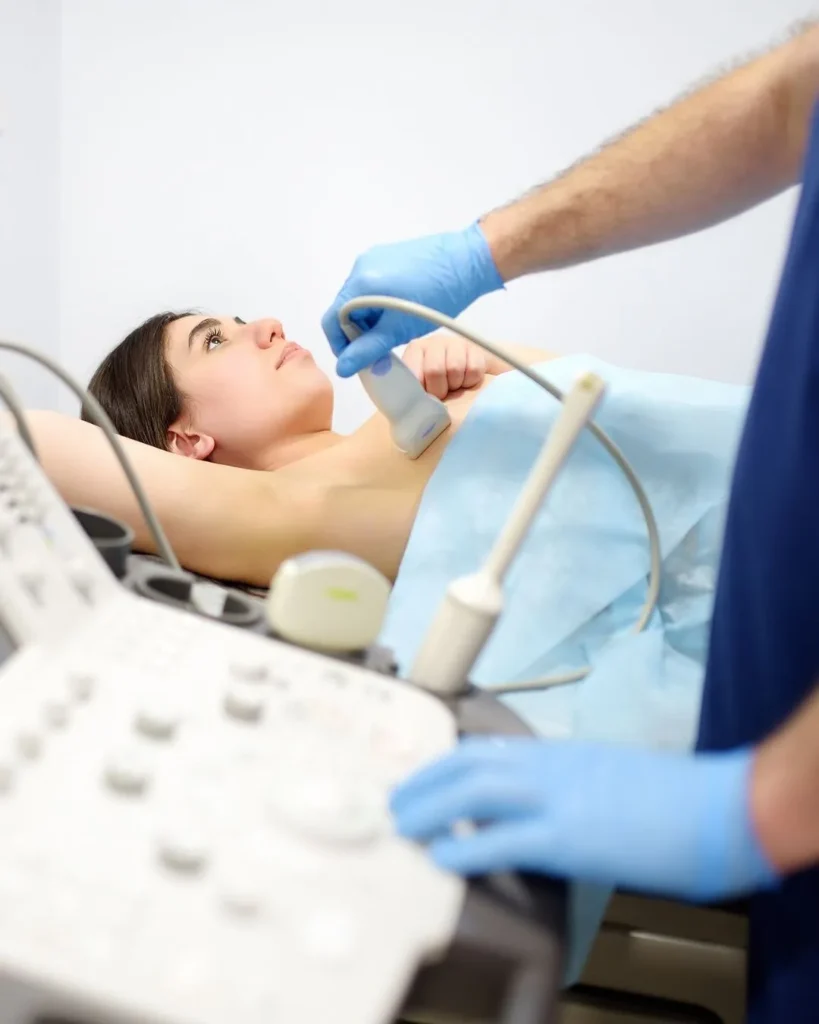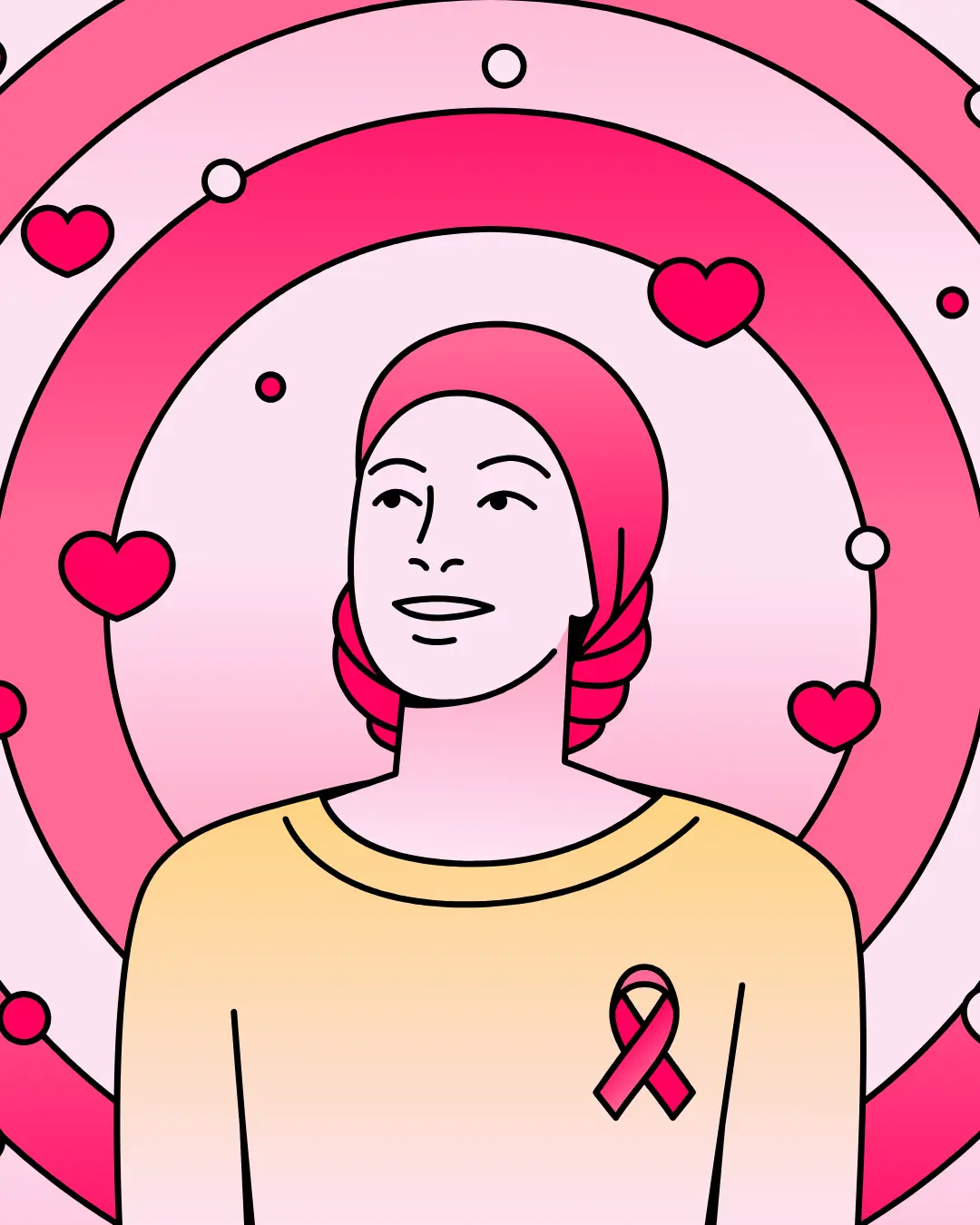Breast cancer is a common illness that impacts millions of women globally. Catching it early and getting prompt treatment is essential for better outcomes. Knowing the symptoms, how it’s diagnosed, and the treatment options can greatly help in managing the disease effectively.
What is Breast Cancer?

Breast cancer starts when cells in the breast grow out of control, forming a malignant tumor that can spread to nearby tissues and other areas of the body. While it can affect both men and women, it’s much more prevalent in women.
Types of Breast Cancer:

1. Ductal Carcinoma In Situ (DCIS):
This is a non-invasive type of breast cancer where abnormal cells are found in the lining of a breast duct but haven’t spread to other tissues.
2. Invasive Ductal Carcinoma (IDC):
The most common type of breast cancer, IDC occurs when cancer cells break out of the ducts and invade surrounding breast tissue.
3. Invasive Lobular Carcinoma (ILC):
This cancer starts in the milk-producing glands (lobules) and spreads to nearby breast tissue.
4. Triple-Negative Breast Cancer:
This type doesn’t have the three common receptors (estrogen, progesterone, and HER2/neu) that typically fuel breast cancer growth, making it more challenging to treat.
5. HER2-Positive Breast Cancer:
In this type, the cancer cells test positive for a protein called HER2, which promotes the growth of cancer cells.
6. Inflammatory Breast Cancer:
A rare and aggressive form, this type of cancer blocks lymph vessels in the skin of the breast, often leading to redness and swelling.
How Risky is Breast Cancer?

Risk Factors:
1. Age: The chance of developing breast cancer rises as you get older.
2. Gender: Women are significantly more likely to develop breast cancer compared to men.
3. Genetics: A family history of breast cancer or genetic mutations like BRCA1 and BRCA2 can significantly raise your risk.
4. Hormonal Factors: Early menstruation, late menopause, and hormone replacement therapy can increase the likelihood of developing breast cancer.
5. Lifestyle Factors: Factors such as alcohol consumption, obesity, lack of physical activity, and certain dietary habits can elevate your risk.
6. Previous Cancer History: Having had breast cancer or certain other cancers in the past can increase the risk.
Risk Level:
1. Prevalence: Breast cancer is one of the most common cancers among women worldwide.
2. Variability: The risk varies greatly depending on individual factors such as genetics, lifestyle, and environmental influences.
3. Detection: Early detection significantly improves prognosis and survival rates.
Survival Rates:
1. Early-Stage: Breast cancer detected at an early stage has a high survival rate, with many patients living beyond 5 years post-diagnosis.
2. Advanced Stages: When breast cancer spreads to other parts of the body, the survival rates are lower, but treatments are continually improving.
Understanding these factors can help in assessing personal risk and the importance of regular screenings and a healthy lifestyle.
Symptoms of Breast Cancer:

Breast cancer can present a range of symptoms, and while these can sometimes be linked to non-cancerous conditions, it’s crucial to consult a healthcare professional for any new, unusual, or persistent changes in the breast.
1. Lump or Mass in the Breast
Description: A lump or mass in the breast is the most common symptom of breast cancer. These lumps are often painless, though they can sometimes be tender.
Characteristics: They might feel hard with irregular edges or be round and soft. Lumps can be either mobile or fixed (immovable).
2. Swelling of All or Part of the Breast
Description: Swelling can occur even if no lump is felt.
Characteristics: The swelling may affect all or part of the breast, leading to noticeable changes in breast size.
3. Skin Irritation or Dimpling
Description: The skin on the breast may become irritated or develop dimples.
Characteristics: This can look like the skin of an orange (known as peau d’orange) and is often associated with inflammatory breast cancer.
4. Breast or Nipple Pain
Description: Persistent pain in the breast or nipple can be a symptom of breast cancer.
Characteristics: This pain is usually continuous and not linked to the menstrual cycle.
5. Nipple Retraction or Inversion
Description: The nipple may turn inward or retract suddenly.
Characteristics: This change can happen suddenly and might be accompanied by other symptoms.
6. Nipple Discharge
Description: Discharge from the nipple, especially if it’s bloody, can be a symptom of breast cancer.
Characteristics: The discharge may be clear, milky, or yellowish. It’s concerning if it occurs spontaneously (without squeezing) and persists.
7. Redness, Scaliness, or Thickening of the Nipple or Breast Skin
Description: The skin of the nipple or breast may become red, scaly, or thickened.
Characteristics: These changes can resemble symptoms of an infection or other skin conditions but warrant medical evaluation if persistent.
8. A Lump or Swelling in the Underarm Lymph Nodes
Description: Swelling or lumps in the lymph nodes under the arm can indicate breast cancer.
Characteristics: These lumps are typically hard and immovable, suggesting that cancer may have spread to the lymph nodes.
Less Common Symptoms:
1. Change in Breast Shape or Size
Description: One breast may change shape or size unexpectedly.
Characteristics: This can result in asymmetry or visible distortion in the breast contour.
2. Unexplained Weight Loss
Description: Significant and unexplained weight loss can be a symptom of various cancers, including breast cancer.
Characteristics: While not specific to breast cancer, it is a concerning sign that should be investigated.
It’s vital to pay attention to any changes in your breast and consult a healthcare professional if you notice any of these symptoms. Early detection and diagnosis are key to effective treatment and better outcomes.
Diagnosis of Breast Cancer:

Early and accurate diagnosis of breast cancer is crucial for effective treatment and management. Here’s a breakdown of the various methods used to diagnose breast cancer:
1. Self-Examination
Description: Regular self-checks can help you spot any unusual changes in your breasts.
Procedure:
- Look in the mirror for changes like unevenness, dimpling, or inverted nipples.
- Use your fingers to feel for lumps or thickened areas, covering the entire breast and underarm.
- Notice any changes in texture, tenderness, or nipple discharge.
2. Clinical Breast Examination (CBE)
Description: A healthcare professional physically examines your breasts.
Procedure:
- The doctor visually inspects and palpates (feels) the breasts for lumps or abnormalities.
- They also check the underarm and collarbone areas for lumps.
3. Mammography
Description: X-ray imaging to detect tumors or abnormalities in the breast.
Types:
1. Screening Mammogram: Routine checks for women without symptoms, typically recommended annually or biennially for women over 40.
2. Diagnostic Mammogram: More detailed imaging for women with symptoms or following a suspicious screening mammogram.
Procedure:
- The breast is placed between two plates and compressed to get clear images from several angles.
4. Ultrasound
Description: High-frequency sound waves create images of the breast tissue.
Procedure:
A handheld device (transducer) is moved over the skin to distinguish between solid masses (possibly cancerous) and fluid-filled cysts (usually benign).
5. Magnetic Resonance Imaging (MRI)
Description: Uses magnetic fields and radio waves for detailed breast images.
Procedure:
- You lie face down on a table with openings for your breasts, which slides into the MRI machine for imaging.
- Often used for high-risk women or to assess cancer extent post-diagnosis.
6. Biopsy
Description: Removal of a breast tissue sample for lab analysis.
Types:
1. Fine-Needle Aspiration (FNA): Uses a thin needle to remove a small tissue or fluid sample.
2. Core Needle Biopsy: Uses a larger needle for a core tissue sample.
3. Stereotactic Biopsy: Uses mammography to guide the needle to the suspicious area.
4. Surgical Biopsy: Removes all or part of a lump for analysis.
Procedure:
- The area is numbed with local anesthesia, and the sample is sent to a pathology lab to check for cancer cells and determine the type of cancer.
7. Histopathological Analysis
Description: Microscopic examination of the biopsy tissue by a pathologist.
Procedure:
- The pathologist looks for cancer characteristics like size, shape, and arrangement of cells to determine the cancer type and grade, guiding treatment decisions.
8. Hormone Receptor Tests
Description: Determines if cancer cells have receptors for hormones like estrogen or progesterone.
Procedure:
- A tumor tissue sample is tested in a lab for hormone receptors, with positive results indicating possible response to hormone therapy.
9. HER2/neu Testing
Description: Checks if cancer cells produce excess HER2 protein, which can promote cancer growth.
Procedure:
- A tumor tissue sample is tested for HER2 protein, with positive results indicating possible response to targeted therapies like trastuzumab (Herceptin).
10. Genetic Testing
Description: Tests for mutations in genes like BRCA1 and BRCA2, increasing breast cancer risk.
Procedure:
- Blood or saliva samples are analyzed for genetic mutations, helping identify high-risk individuals and influencing treatment decisions.
These diagnostic methods, from self-examinations to genetic testing, are essential for detecting breast cancer early and determining the best course of action for treatment. Regular screenings and prompt medical evaluation of any changes are key to successful outcomes.
Treatment of Breast Cancer:

Treating breast cancer depends on its type, stage, and characteristics, as well as the patient’s overall health and preferences. Here are the main treatment options:
1. Surgery
Lumpectomy:
- Removes the tumor and a small margin of surrounding healthy tissue.
- Preserves most of the breast, often followed by radiation therapy to target any remaining cancer cells.
Mastectomy:
Involves removing one or both breasts, partially or completely.
Types:
- Simple or Total Mastectomy: Removes the entire breast without lymph nodes.
- Modified Radical Mastectomy: Removes the entire breast and some underarm lymph nodes.
- Radical Mastectomy: Removes the entire breast, lymph nodes, and chest wall muscles (rarely performed).
Necessary for larger or more widespread cancers.
Sentinel Lymph Node Biopsy:
- Removes a few sentinel lymph nodes to check for cancer spread.
- Minimally invasive.
Axillary Lymph Node Dissection:
- Removes multiple lymph nodes in the underarm area if cancer is found in sentinel nodes.
- Helps determine cancer spread and guides further treatment.
2. Radiation Therapy
External Beam Radiation:
- Targets the breast with high-energy X-rays from an external machine.
- Administered five times a week over the course of several weeks.
- Kills cancer cells left after surgery, reducing recurrence risk.
Internal Radiation (Brachytherapy):
- Places radioactive seeds or pellets inside the breast tissue near the tumor.
- Shorter treatment course than external radiation.
- Delivers a high dose of radiation directly to the tumor site with minimal exposure to surrounding tissues.
3. Chemotherapy
Description: Uses drugs to kill or stop the growth of cancer cells.
Types:
- Neoadjuvant Chemotherapy: Given before surgery to shrink tumors.
- Adjuvant Chemotherapy: Given after surgery to reduce any remaining cancer cells.
Procedure: Administered orally, intravenously, or through injections.
Benefits: Effective for treating cancer that has spread beyond the breast and for shrinking tumors before surgery.
4. Hormone Therapy
Description: Blocks the body’s natural hormones that can fuel certain types of breast cancer.
Types:
- Selective Estrogen Receptor Modulators (SERMs): Drugs like tamoxifen block estrogen receptors on cancer cells.
- Aromatase Inhibitors: Drugs like anastrozole, letrozole, and exemestane lower estrogen levels in postmenopausal women.
Procedure: Taken as pills or injections over several years.
Benefits: Reduces the risk of recurrence in hormone receptor-positive breast cancers.
5. Targeted Therapy
Description: Uses drugs that specifically target cancer cells with certain characteristics.
Types:
- HER2-Targeted Therapies: Drugs like trastuzumab (Herceptin) and pertuzumab (Perjeta) target HER2-positive breast cancer.
- CDK4/6 Inhibitors: Drugs like palbociclib, ribociclib, and abemaciclib block proteins promoting cancer cell growth.
Procedure: Administered orally or intravenously.
Benefits: More precise treatment with fewer side effects compared to chemotherapy.
6. Immunotherapy
Description: Uses the body’s immune system to fight cancer.
Types:
- Immune Checkpoint Inhibitors: Drugs like pembrolizumab (Keytruda) help the immune system recognize and attack cancer cells.
Procedure: Administered intravenously.
Benefits: Effective for certain types of breast cancer, particularly triple-negative breast cancer.
7. Clinical Trials
Description: Research studies that test new treatments or new combinations of treatments.
Benefits: Provides access to cutting-edge therapies and contributes to medical research that may benefit future patients.
8. Palliative Care
Description: Focuses on relieving symptoms and improving the quality of life for patients with advanced breast cancer.
Procedure: Includes pain management, nutritional support, and psychological support.
Benefits: Enhances comfort and well-being during all stages of cancer treatment.
Understanding the symptoms, undergoing regular screenings, and seeking prompt medical attention if changes are noticed can significantly improve the management of breast cancer. Early diagnosis and a comprehensive, personalized treatment plan can lead to better outcomes and an improved quality of life for those affected.
